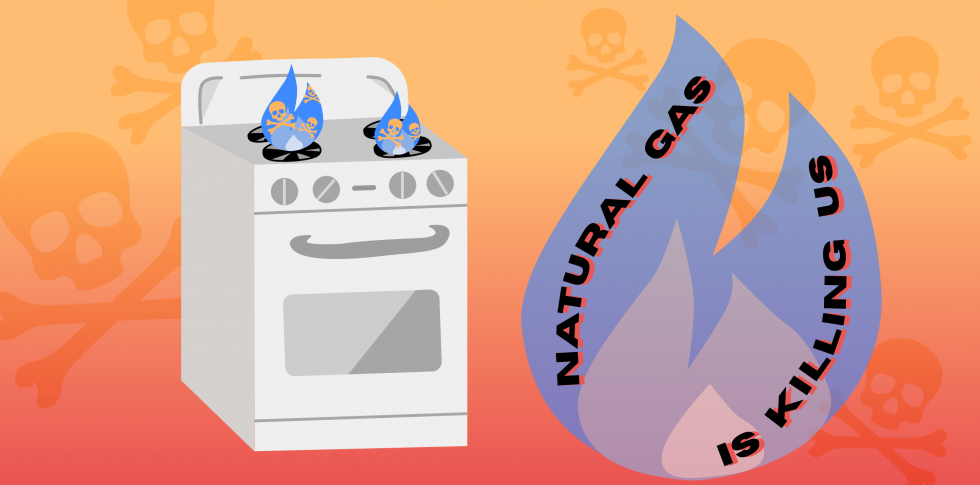There’s an opportunity to decarbonize the buildings we live in — with huge potential impacts for our climate.
Don’t be fooled by the word “natural” in its name: Natural gas is a toxic fossil fuel that contributed over 1.6 million metric tons of CO2 into our atmosphere from the U.S. alone in 2019 (EIA). The industry has historically tried many attempts at positioning this polluting energy source to make it sound like a more sustainable option —including just-as-toxic “renewable” versions recently touted in misleading branding (“a desperate bid by natural gas utilities to delay their inevitable decline,” according to a 2020 Vox piece) — but moving away from natural gas is critical to achieving the zero-emissions targets we urgently need to stabilize the climate.
At its face, this challenge can seem daunting; so much of our natural gas consumption happens in infrastructure that appears intimidating to overhaul. It is inspiring to learn then that there is already significant momentum and precedent for moving away from natural gas, and clear policy opportunities available that we can impact to ensure this transition happens at the pace and scale needed to achieve our climate goals.
In California, over 20% of all natural gas utilization is for residential use — making this home usage a significant opportunity to impact overall natural gas emissions (EIA). Many of us — about half of U.S. households (EIA), and 70% of Californian stoves (Sierra Club) — use natural gas in our homes to heat water, food (cooking), clothes (for drying) and the house (gas-powered furnaces). In addition to emitting greenhouse cases, using gas in homes also has shocking negative health impacts.
Growing up in a home with a gas stove, I never thought about any potential health impacts of using gas inside the home, but research increasingly shows the air quality impacts of gas stoves to be severe: According to a recent UCLA study, “after an hour of cooking on a gas stove, 98% of smaller apartments had peak levels of NO2 that exceeded these state and national air-quality standards” — meaning, “the air quality inside nearly every apartment was so bad that it would be illegal if measured outside” and contributing to health issues including increased rates of asthma and bronchitis (Sierra Club). The same study estimated that the benefits of electrification in terms of health costs saved would be over a billion dollars for the San Francisco Bay Area alone (Sierra Club).
This is where building electrification comes in:
For the climate and for our health, residential use of natural gas must end. Luckily, the required technologies — electric alternatives to gas appliances — already exist and are even cost-competitive: Heat pumps can replace gas-powered furnaces, and induction cooking is now promoted by many top chefs as an even preferable mode for controlling cooking (CleanTechnica).
However, many consumers don’t know about these options, or find the cost of switch from existing appliances to be too great. The cost of switching from gas to electric appliances can be significant; this is why it’s so critical we push for building electrification at the point of new construction to ensure that new development is built in a way that is healthy and sustainable in the long run. (There are also policy mechanisms available for promoting conversions of existing construction — some shared by the Sierra Club’s Senior Campaign Representative Matt Gough at a recent presentation include Point of Sale Ordinances, Burnout Ordinances, “Cash for Clunkers,” or Renovation requirements as opportunities to impact existing buildings — but these are much harder and more costly to implement than ensuring buildings are electric to begin with.)
Getting natural gas out of our existing buildings and banned from new development is a key strategic priority to achieve our climate goals, so it’s exciting that there is already huge progress on this in the Bay Area: Over thirty Bay Area jurisdictions have enacted ordinances to promote building electrification already. This contributes to a positive feedback loop, showing how delegitimized natural gas will soon be; the more cities choose to promote electric-only new construction, the more obsolete natural gas infrastructure will become. There is a significant equity component here that needs to be addressed too, as homes that can afford it make the upgrade to all-electric appliances and natural gas becomes more expensive, policies need to ensure that all households can afford to switch to electric so as not to become unfairly overburdened with energy costs.
Continuing to fund new natural gas infrastructure is clearly a bad investment, and cities around California have already recognized this with policies promoting electric-only new development. Thoughtful, coordinated regional and statewide policies — accelerated by members of organizations including 350 Bay Area — will set us on the right track to ensuring everyone has access to affordable clean energy and a stable climate for future generations.
-by Allison Cooper, member of the 350 Bay Area Mobilizing Team, a trained Climate Reality Leader and a San Francisco 2020 fellow with the Clean Energy Leadership Institute.
A special thank you to the presenters at two events I attended — Panama Bartholomy’s presentation to the Clean Energy Leadership Institute 2020 SF fellowship, and Matt Gough’s presentation to the Climate Reality Project Bay Area chapter — for inspiring this research.

